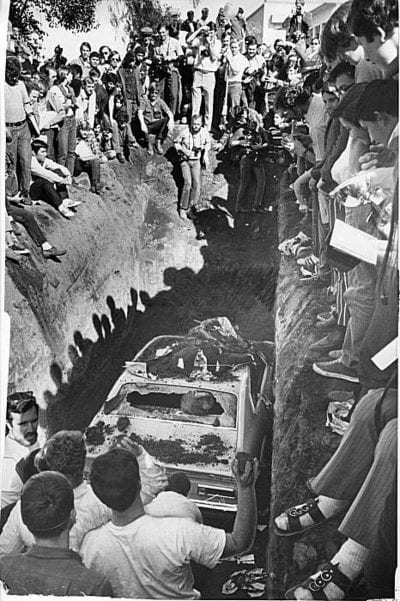SJSU’s Strong Ties to Earth Day Highlight University’s History of Action
The history of Earth Day has Spartan fingerprints all over it.
Flash back to Feb. 24, 1970 — faculty and students at San José State College (now SJSU) called for the end of internal combustion automobiles at Survival Faire’s Great Car Burial, where a brand new 1970 Ford Maverick was buried on campus.*

At the Survival Faire’s Great Car Burial in 1970, faculty and students at San José State College (now SJSU) called for the end of internal combustion automobiles by burying a brand new Ford Maverick. Photo from Spartan Daily.
Two months later, San José State alumnus Gaylord Nelson, ’39 Political Science, held the first nationwide teach-in on the environment, which became Earth Day, sparking a movement that has only grown more significant in the past 53 years.
It is not widely known if Nelson, who was a U.S. Senator for the state of Wisconsin at the time, knew about the demonstration at his alma mater. But it is clear that SJSU and Spartan alumni are at the forefront of promoting social and environmental justice through civic action.
Fast forward to the SJSU of today — there are many ways in which Spartans are studying and engaging with a changing world. From ocean health to outer space and every point in between, the focus on climate science and saving our planet continues at San José State, where research opportunities continue to grow.
According to the ‘23 National Science Foundation Higher Education Research and Development survey, SJSU is #1 in research among all non PhD granting universities. SJSU’s research, scholarship, and creative activity (RSCA) has grown more than 53% in the last 4 years, with plans to double research spending by 2030.
Many faculty and students are examining a fascinating array of research issues that impact climate change. Here are a just few climate related research projects currently underway:
Assistant Professor Jessica Castillo-Vardaro, Biology, studies mammals and how they adapt to changing temperatures and environments in mountain environments. Learn more here.
Associate Professor Minghui Diao, Meteorology and Climate Science, researches ice and mixed-phase clouds, providing accurate quantification on the climate impacts of cirrus clouds. Learn more here.
Assistant Professor Maya deVries, Biology, investigates climate change stressors such as ocean acidification and ocean warming, and how they’re impacting marine food webs. Learn more here.
Professor Phil Heller, ’08 MS Computer Science, Computer Science, uses AI Deep Learning on tens of thousands of microphotographs to study changing ocean habitats. Learn more here.
Professor Amanda Kahn, Invertebrate Ecology, studies how climate change affects marine sponges and corals, which are both important members of the marine community. Learn more here.
Professor Kate Wilkins, Biology, studies the ecology of areas that buffer climate change and allow species to persist in or expand under changing environmental conditions. Learn more here.
*Editor’s note: The car was dug up in Oct. 1970, compacted, and used as the cornerstone for the first rapid transit terminal in Santa Clara County.




